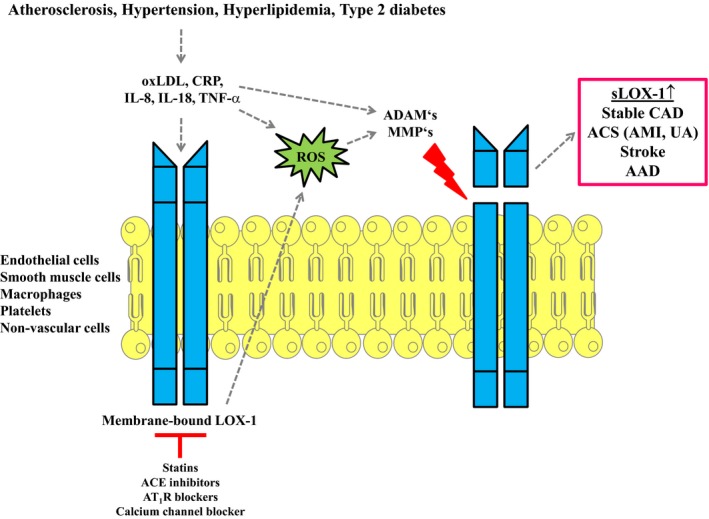Figure 1.

Generation of sLOX‐1 (soluble lectin‐like oxidized low‐density lipoprotein receptor 1) from the membrane‐bound form. LOX‐1 expression is found on endothelial cells, smooth muscle cells, macrophages, platelets, and nonvascular cells. Proinflammatory mediators oxidized LDL (oxLDL), CRP (C‐reactive protein), IL‐8 (interleukin 8), IL‐18, or TNF‐α (tumor necrosis factor α) induce the shedding of cell‐membrane‐bound LOX‐1. This process involves reactive oxygen species (ROS) and the activation of matrix‐degrading enzymes ADAMs (a disintegrin and metalloprotease) and MMPs (matrix metalloproteases). ROS are generated by different enzymatic sources in vascular cells. Their formation is increased on activation of LOX‐1 and direct effects of oxLDL or TNF‐α on ROS producing enzymes. The proteolytic cleavage in the extracellular neck domain of membrane‐bound LOX‐1 leads to the release of the shorter sLOX‐1. Elevated sLOX‐1 concentrations are shown in stable coronary artery disease (CAD), acute myocardial infarction (AMI), stroke, and acute aortic dissections (AAD). Proinflammatory mediators that stimulate sLOX‐1 release are increased in atherosclerosis, hypertension, hyperlipidemia or type 2 diabetes mellitus. In addition, sLOX‐1 may even present a pathophysiologic link among these diseases. Interpretation of results has to involve adjustment for other comorbidities and pharmacologic therapy with statins, angiotensin‐converting enzyme (ACE) inhibitors, angiotensin receptor II type 1 (ATR 1) blockers, or calcium channel blockers that might affect LOX‐1 expression and sLOX‐1 release. Figure adapted from SMART—Servier Medical Art by Servier (https://smart.servier.com). UA indicates unstable angina.
